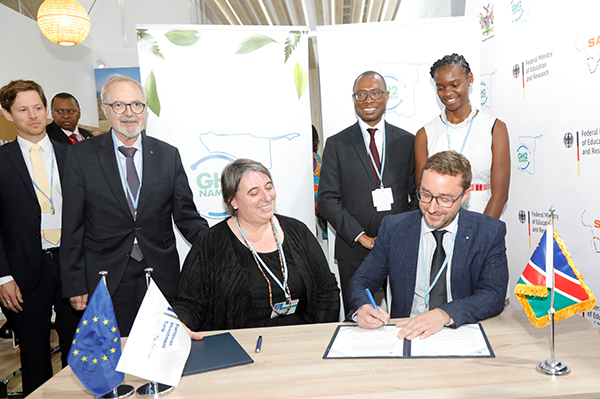OMARURU – The Namibia Power Corporation on Friday inaugurated its fully-owned and operated renewable energy plant, the Omburu 20MW PV power station. The project is one of four renewable energy-generation projects aimed at increasing local generation capacity and ensuring security of supply.
“These generation projects will reduce the overall NamPower tariff to the customer by introducing affordable renewable energy to the Namibian grid,” said NamPower managing director Kahenge Haulofu at the event.
He added that the projects will further support commitments made at the last United Nations climate change conference, COP26, to reduce Namibia’s emissions by 91% within the next five years. The solar power plant also supports Namibia’s energy and renewable energy policy targets for 70% of renewable energy generation by 2030.
The plant was developed and constructed by a joint venture of Hopsol Africa and Tulive Private Equity at a cost of N$317 million. It is situated about 12km outside Omaruru in the Erongo region. The entire station covers a footprint of approximately 42 hectares.
The Nampower MD noted that the total workforce involved in the project were Namibians, with all of the semi-skilled and unskilled labourers sourced from the Omaruru local community.
At Friday’s inauguration, acting CEO of the Electricity Control Board Rachel Boois said Namibia must take advantage of developments in the renewable energy sector to enhance security of electricity supply in the country. In 2020, N$500 million was allocated from the Long Run Marginal Cost (LRMC) fund for the construction of NamPower’s renewable energy plants.
“The LRMC fund is intended to ensure a smooth tariff path for the future, and also to cushion customers from unexpected tariff hikes, or in situations where the economy is too depressed to build new power plants that will ensure an affordable projected tariff path,” she explained.
In this regard, Boois stated that N$342 million was allocated to the 20 MW solar PV plant at Omburu. The remaining N$158 million will be considered for allocation as funding for a 40MW NamPower-owned wind plant.
Since the plant was customer-funded, only minimal operational costs are recovered through the approved tariff. According to the acting ECB CEO, the NamPower Omburu power plant is currently the cheapest source of electricity in the regulator’s energy mix, thus contributing to a reduction in tariff increases.
In accordance with the tariff methodology, NamPower will not be allowed a return on depreciation on assets created using the N$500 million LRMC contribution. Boois affirmed that this will result in the total net savings to the customers of approximately N$1 billion over a period of 30 years, and will assist in improving the affordability of electricity to end-users.
Inaugurating the 20MW power station, energy deputy minister Kornelia Shilunga observed that one of the desired outcomes and goals regarding electricity supply during the Harambee period is to increase the local electricity generation capacity. This, she said, will ensure access to secure, reliable and safe supply of electricity for citizens to conduct business, attract foreign direct investment, and stimulate economic growth.
According to her, the ministry had approved a number of policies such as the National Renewable Energy Policy, National Energy Policy and the Independent Power Producers’ (IPP) policy to support this power trajectory.
“These policy instruments are aimed at encouraging investment in Namibia’s renewable energy sector and the development of clean, green energy for our country,” noted Shilunga.
Government is further committed to increasing local electricity generation capacity from 624MW to 879MW by 2025 through commissioning 50MW of Independent Power Producer (IPP) projects, and an additional 220MW generation by NamPower by 2025.
Shilunga said this includes providing electricity to 213 new schools and health facilities, while electrifying 6000 rural and 13 000 peri-urban households.
The deputy minister added that Namibia is blessed with renewable energy sources, which largely remain untapped. There is thus a wealth of opportunities in the expansion and production of renewable energy sources, a drive that is set well on the way to closing the energy gap on the continent, while contributing to the acceleration of an energy transition.
Furthermore, Shilunga said Namibia now forms part of the green hydrogen compact catalogue. “The country has resolved to explore the possibility of green hydrogen, a product that offers a unique opportunity to not only increase the development of renewable energy on the continent, but also offers several new market opportunities”. –mndjavera@nepc.com.na


